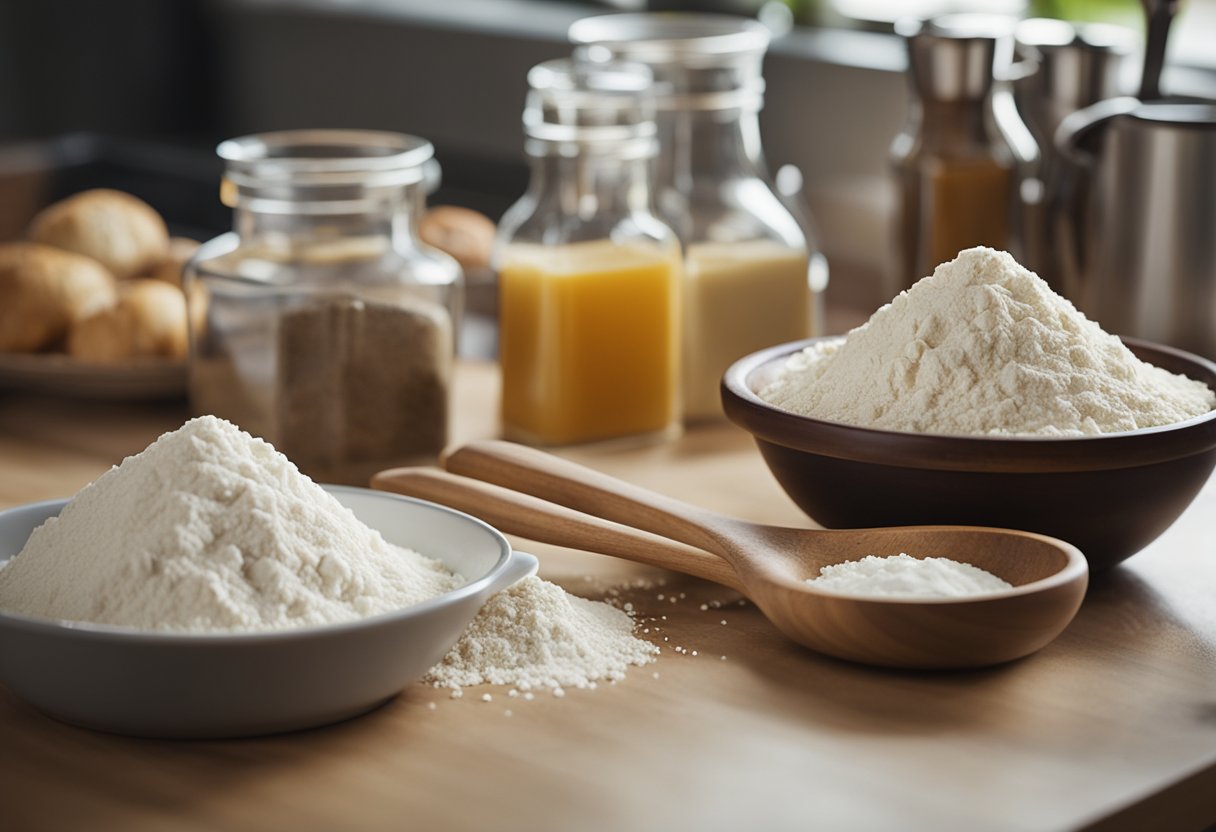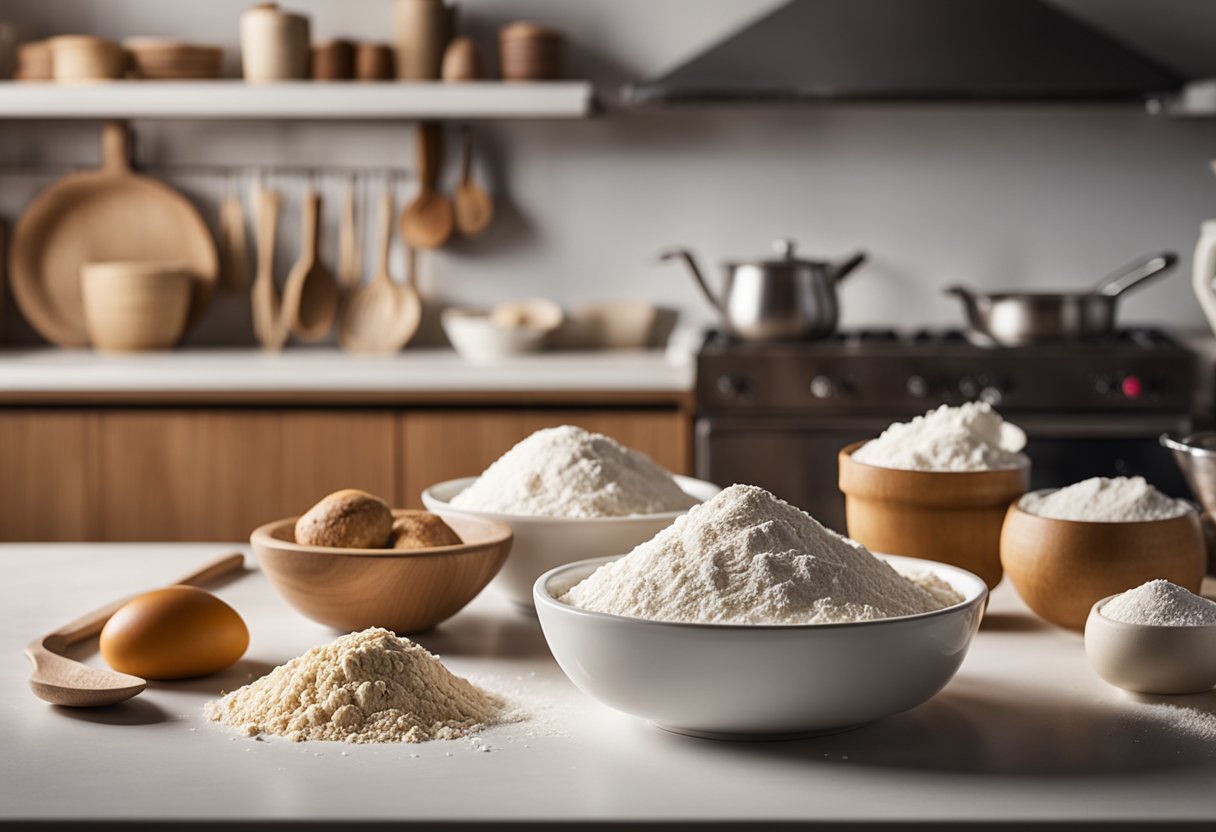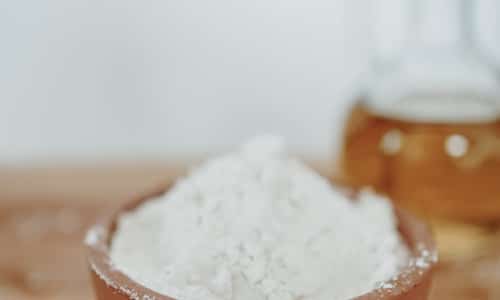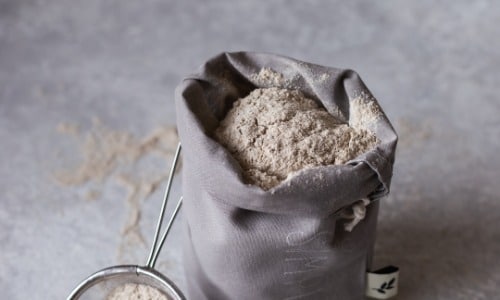When you find yourself with more flour than you can use, proper storage is key to maintaining its freshness and usability. Let me guide you through the essentials of preserving your flour stash with no fuss. We will also share a few yummy recipes that you can use with your extra flour.
Storing Excess Flour Properly

Understanding Flour Preservation
Your flour can stay fresh and ready for your next baking adventure with the right approach. Whole-grain flours contain natural oils that can spoil, so it’s important to note the expiration date and store them wisely to maximize their lifespan.
Container Choices for Optimal Freshness
Storing flour in an airtight container is vital. Here are prime options:
- Glass jars with sealing lids
- Plastic containers with airtight covers
- Metal bins with snug-fitting lids
The goal is to shield your flour from air, moisture, and pests.
Ideal Conditions for Flour Storage
Finding the perfect spot for your flour means considering these factors:
- Pantry: Cool, dry, and dark, ideal for short-term storage of all-purpose and self-rising flour.
- Fridge/Freezer: Best for whole-grain flours, to keep those natural oils fresh.
- Remember, consistency is your friend; drastic changes can affect quality.
Creative Baking Ideas with Excess Flour

Having excess flour presents the perfect opportunity to explore and experiment with your baking skills. You can create a variety of breads, savory dishes, and delightful sweets that you and your loved ones can enjoy.
Homemade Breads and Pastries
- Bread Recipe: Dive into the world of homemade sourdough bread. It’s a spending way to use your flour and learn a timeless culinary skill.
- Pastries: Why not try your hand at crafting flaky biscuits or buttery scones? These baked goods make for a comforting breakfast or teatime treat.
Savory Dishes and Pasta Creativity
- Pasta: Transform your flour into homemade pasta noodles—a surefire way to impress at the dinner table.
- Pizza: Gather your favorite toppings and use your excess flour to create a delightful homemade pizza crust that’s leagues above store-bought varieties.
Sweet Treats and Delights
- Cakes: Unleash your inner pastry chef by baking up a storm—layer cakes, cupcakes, or a simple sheet cake to satisfy your sweet tooth.
- Cookie Dough: Mix up a batch of cookie dough; it’s not only great for cookies but can also be used to make bars, truffles, or even a cookie pizza.
Alternative Uses for Flour
When you find yourself with more flour than baking requires, consider exploring its versatility in cooking, crafts, and even household chores.
Thickening Agent for Cooking
With just a sprinkle of flour, you can transform your gravies, soups, and sauces into rich, velvety delights. To achieve the perfect consistency, whisk a bit of flour into a portion of the broth to create a smooth slurry, then add it to your recipe. This prevents lumps and ensures your dish maintains an even texture throughout.
Craft and Play for Children and Adults
Flour isn’t just for the kitchen—it’s a gateway to creativity. For a simple homemade play dough, mix 2 cups of flour with 1/2 cup of salt, 2 tablespoons of cream of tartar, and food coloring for a burst of color. Cook over low heat with 1 cup water until your playful creation comes together in a doughy consistency, ready to be molded into whatever your imagination fancies.
Cleaning and Polishing Applications
Did you know flour can help in cleaning and adding shine to your home? It’s remarkable for buffing stainless steel and copper, giving it a natural, gentle polish. For a fresh scent and extra cleaning power, you can mix some flour with a dash of baking soda to tackle unwanted odors and grime on various surfaces. Always use a soft cloth to gently rub the mixture on the surfaces, and marvel as they regain their original sparkle.
Preventing and Dealing with Flour Pests

Storing flour properly is essential to prevent pests and maintain its quality. Here’s what you need to know to keep your flour bug-free and fresh.
Common Pests in the Pantry
Your pantry may attract weevils, small beetles that love to feast on grains, or flour moths, which lay their eggs in powdery foodstuffs. Both can contaminate flour and affect its quality, leaving behind an off-putting odor and taste.
Preventative Measures
- Store flour in airtight containers: This creates a barrier against pests and preserves the flour’s freshness.
- Check regularly: Inspect your flour often for signs of infestation, like clumps or traces of webs.
- Use bay leaves: These can act as a natural deterrent; place a few inside your flour container to keep bugs at bay.
Handling Infestations
- Dispose of infested flour: If bugs make an appearance, it’s time to say goodbye to that batch of flour.
- Clean with vinegar: After tossing the infested flour, scrub your storage area with a vinegar solution to kill lingering pests and eliminate odors.
- Seal gaps: Check for and seal off any entry points like cracks or openings around your pantry shelves to prevent future invasions.
Maintaining Flour Quality and Consistency

When dealing with excess flour, your priority is keeping it fresh for your baking adventures. Store flour in an airtight container; this protects it from moisture and pests, ensuring it remains your trusted pantry staple. Your sourdough starter will thank you for using fresh flour, resulting in lively and happy starters ready for that perfect sourdough bread.
Flouring a surface? Go easy – use just enough to prevent sticking, keeping your dough supple but not dry. Over-flouring your countertop can make your dough tough when you’re kneading, and nobody wants that! A bench scraper is your pal here to neatly pick up any excess without wasting it.
Keep your baking tools like pastry brushes or spatulas clean and free from gunk build-up. You can’t go wrong with a quick swipe of a damp paper towel. If you’ve had an ‘oops’ with flour on your utensils, a pastry scraper acts like a credit card to scrape off the bits, keeping tools in tip-top shape for your next baking session.
For pans that need greasing, consider using shortening and a light dusting of flour to create a non-stick surface, or skip the mess and line with parchment paper. After baking, if sourdough discard has you puzzled, mix it into pancakes or crackers, giving credit to every grain. Last but not least, keep your flour hydration-friendly – maintain consistency by measuring your water with care, ensuring that every knead leads to perfection.
Frequently Asked Questions
Exploring unique ways to utilize excess flour can transform it from a surplus item in your pantry to a versatile ingredient for your meals and activities.
How can I utilize a large amount of all-purpose flour?
You can tackle that mountain of all-purpose flour by preparing homemade bread, pizza dough, or even pasta. These staple items don’t just whittle down your flour stash—they also allow you to enjoy fresh, home-cooked treats.
What are some easy recipes that only require flour and water?
Unleash simplicity with recipes like tortillas, crepes, or chapatis, which basically need just flour and water. Perfecting these can lead to an endless variety of meals, from tacos to delectable wraps!
Can you suggest some simple breakfast ideas using flour?
Start your day right with fluffy pancakes or waffles made primarily with flour. If you’re feeling adventurous, a classic French quiche with a homemade crust will elevate your morning routine.
Are there any flour-based dinner recipes that are quick to make?
Whip up a speedy homemade gnocchi or a rustic galette for dinner tonight. These dishes are not only quick to make but deliciously satisfying, especially with your favorite toppings and fillings.
What fun crafts or activities can involve flour?
Get creative with flour-based playdough or paper-mâché for a fun day of crafting. You can also make your own eco-friendly glue with just a bit of flour and water.
How can leftover flour be repurposed after breading or frying food?
After coating or frying, use the remaining flour to thicken sauces or soups. It’s a resourceful way to enhance your dishes while reducing waste.
